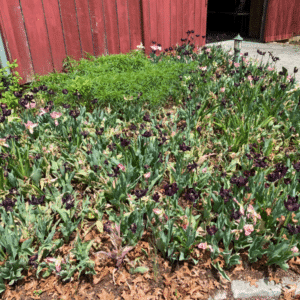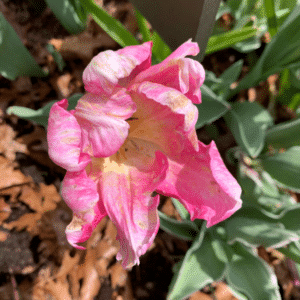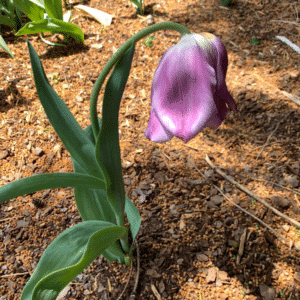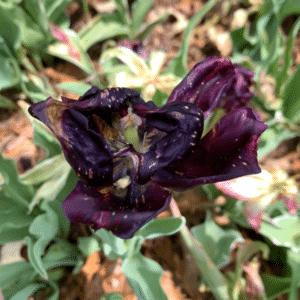The Big Bloom
An annual display of spring-blooming bulbs
What is The Big Bloom?
The Big Bloom at Yew Dell is an annual display of spring-blooming bulbs, such as Tulips, Hyacinths, Daffodils and many others. Each summer, the displays are designed in-house by our team of horticulturists, which range in scale from containers to mass landscape plantings. In the fall, the bulbs are planted, with the help of volunteers, and remain in the ground dormant until emerging in the springtime.
Throughout the gardens, there is something in bloom every day of the year, but oftentimes they are easily missed. Like a lone Helleborus niger (Lenten Rose) blooming in the Millstone Garden in December. So in 2018, we dove into the world of spring bulbs, as an opportunity to bring more plant diversity into the garden and to educate the community on what is possible in a Kentucky garden.

A learning process...
Horticulture, the art and science of growing plants, is a definition we can all relate to in our gardening endeavors. Many would argue that killing plants is the truest definition, as we definitely learn a lot in these moments. It holds true at Yew Dell in our bulb planting efforts from issues with fungi, frozen soil and too much water. We have made many mistakes and we aren’t afraid to share them, so you don’t have to make the same.
2022: Fusarium oxysporum (Fungi)
In the third spring of The Big Bloom, the Visitor Center display emerged and was quickly wiped out by a soil borne fungus Fusarium oxysporum. This fungi is often amplified and transferred in the bulb cultivation process late in the flowering stage and before harvesting when soil temperatures are warmer. When bulbs arrive in the fall it is important to look for these signs:
- Sour smell
- White mycelium (mold)
- Low weight
- Secondary blue-green fungus (Pennicilium)
Unfortunately we were not aware of these signs, so once the displays were planted and emerging in the spring we saw these symptoms:
- Stunted growth
- Purple foliage
- Reduced rooting
- Necrotic spots on blooms
With a hard lesson learned and some time researching we developed three new guidelines for the Big Bloom:
- Tulip Hybrids: The large flowering cultivars that we typically think of during spring are amongst the most susceptible to disease problems during both the cultivation process and in the Kentucky climate.
- Avoid Monoculture: Planting greater diversity ensures that the occasional disease problem won’t wipe out your whole display.
- Crop Rotation: The same practice used in vegetable/crop production can be utilized in annual/tropical plants. It keeps pests at bay naturally — whether that’s insects, fungi, or viruses. Rather than planting the same variety in the same place year after year after year, changing up your plantings each year can reduce the buildup of crop-specific insect or disease pests.
2023: Repurposing Perennials
Responding to the disastrous fungus of the past spring, the displays underwent a massive diversification, so much so that we don’t recommend doing this on a large scale, simply because of the time needed. During the design process, we selected areas that had been planted heavily in Tulip and incorporated perennials in their place. Here are a few examples:
- Visitor Center: Mass of Daffodil and Ornamental Onion mixture
- Castle: Mass of Hyacinth and Daffodil with Tulip and Fritillary sprinkled in
- Glasshouse Terrace Planters: Block planting of Daffodil, Fritillary and Ornamental Onion
Once the displays finished in May, the perennial bulbs were sorted out, set aside to go dormant, cleaned, then planted into the permanent collections. This process took months, working around spring annual planting and regular garden maintenance, it was good in thought. Alongside utilizing our three new guidelines we also utilized a biological fungicide (beneficial bacteria), which was watered in through the season. All with the goal of keeping the fungi from building up in the garden beds. All of these measures worked and the displays looked wonderful, but it was a bit unrealistic especially for home gardeners, so here’s more guidelines.
- Perennials as Annuals: Perennials (as long as cost effective) make for fantastic additions to an annual display, but only with the intention to compost them or give them away at the end of the season.
- Managing Pests: We practice what we preach, and dragging an unwieldy water tank of beneficial fungi wasn’t the easiest and definitely not something we would recommend you do at home. It was a hassle, a bit smelly, an extra expense and avoidable through cultural practices.
2024: Perennials as Annuals
With a successful past spring and only a few sightings of Fusarium in random displays, we went into this spring with high spirits as well as fewer planting areas, due to the Castle Gardens construction. Each planting utilized at least one cultivar of Tulip (planted lightly), Hyacinth and Daffodil. Creating long-lasting, colorful and whimsical displays. At the end of the season no issues were found, and our soil is on the road to recovery.
2025: Swiss Chard Switch Up
So we like plants, gardening, making more work for ourselves, it’s what we do! All for the love of horticulture and getting each and every one of you excited about horticulture. While the Castle Gardens are being renovated, our team established three new annual display beds, requiring a record number of bulbs to be ordered, 27,675 to be exact! In response to our rapid growth and desire to change it up, we attempted adding cool season annuals to the displays, as well as more perennials in the permanent collections. In the nursery 335~ Swiss Chard (Beta vulgaris ‘Bright Lights’ and ‘Perpetual Spinach’) were grown from seed for planting in the garden in late March. The goal was to cover more area with the displays in a cost-effective and impactful way. The Swiss Chards were installed in late March,around two to three inches tall, and were removed in May, around 10 to 12 inches tall. Having never done this before, we goofed on the timing, wanting a full-size plant at the time of planting rather than a small plug. Another guideline was formed:
- Cool Season Foliage: Start seeds early enough in the winter season (add up days to germination and days to harvest) in order to have a close to finished/harvestable product to install into the spring bulb displays.
2026: Cool Season Foliage
The Castle Gardens are open, including two renovated annual planting beds and an amazing collection of planters. Another record year for the spring bulb order with a total of 26,956; 21,751 annuals and 5,205 perennials! With an increase in perennials, these will be scattered throughout the permanent collections including, in the Entrance, Castle, Overlook, Rain, Serpentine, Walled and Glen Shade Garden. With a good plan in place and amazing designs for next spring, we will be incorporating cool season foliage into the Big Bloom displays again in 2026. Be sure to come to the gardens from March through May to see how we’ve done!









